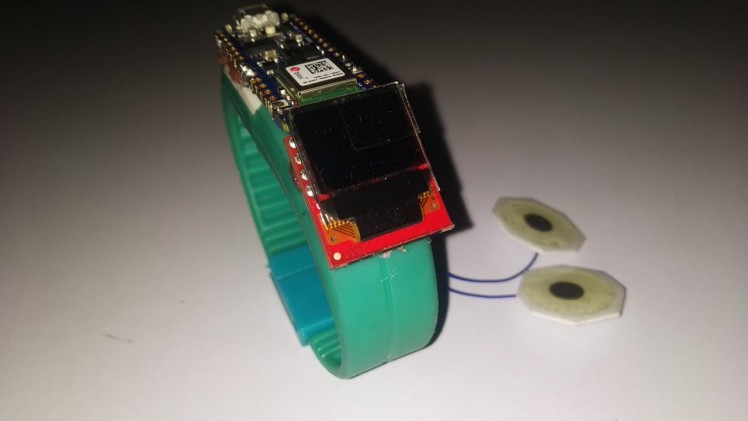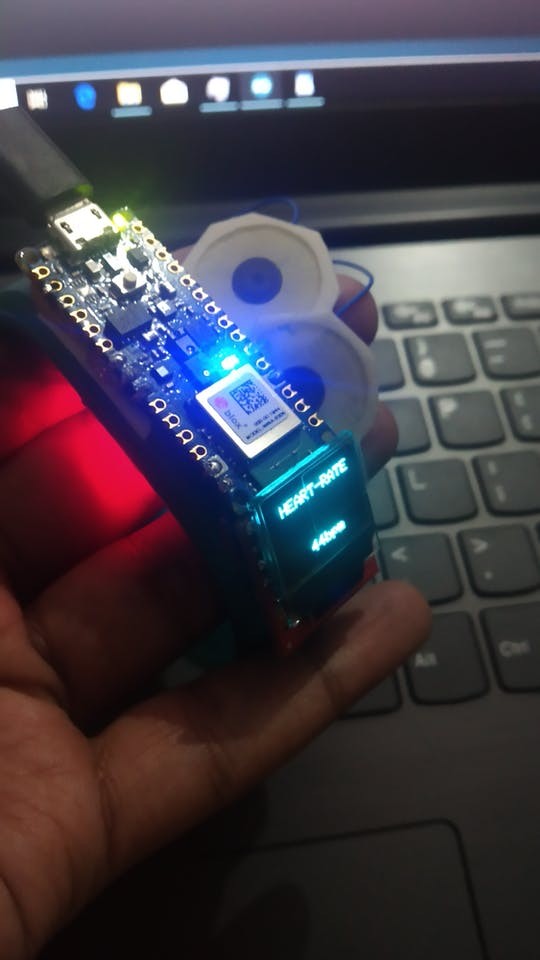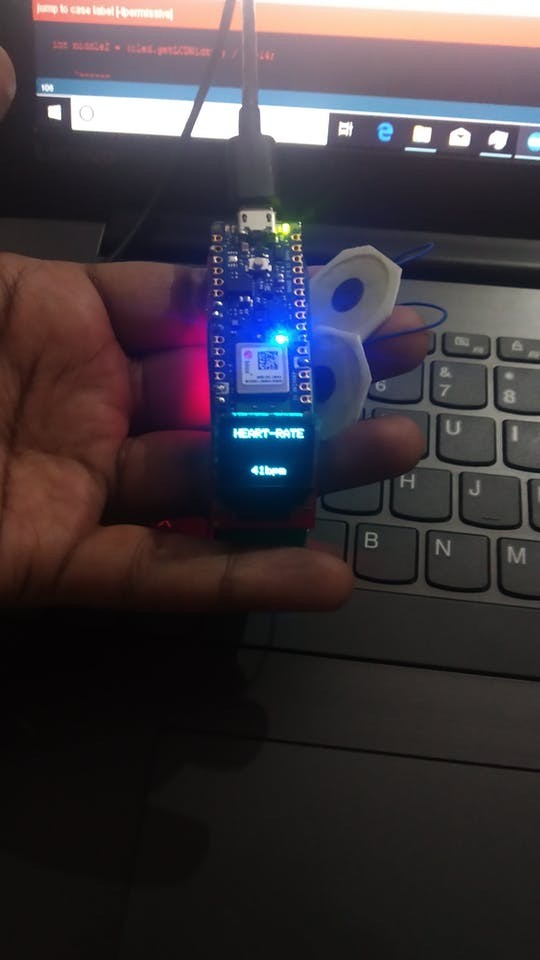
The B&nd
About the project
Monitoring your vitality on the go with BLE5.0, AI & a bunch of cool sensors..
Project info
Difficulty: Moderate
Platforms: Android, Arduino, Maxim Integrated, SparkFun, Nordic Semiconductor
Estimated time: 2 weeks
License: MIT license (MIT)
Items used in this project
Hardware components
Story
A 'little' insight on "bigger" topic..
Menopause is a time of major hormonal, physical and psychological change for women although menopausal symptoms vary from woman to woman. During theperi-menopause or transition phase, there is redundant decrease in production of estrogen and progesterone hormone. If a woman has undergone (oophorectomy), periods end abruptly and menopausal symptoms become more severe. One year after menstrual periods have stopped, a woman reaches menopause, on average around the age of 50.
Impact of Menopause on Sleep-Pattern:
From peri-menopause to post-menopause, women report the most sleeping problems. Most notably, these include hot flashes, mood-disorders, insomnia and sleep-disordered breathing. Sleep problems are often accompanied by depression and anxiety. Generally, post-menopausal women are less satisfied with their sleep and as many as 61% report insomnia symptoms. Snoring has also been found to be more common and severe in post-menopausal women. Snoring, along with pauses or gasps in breathing are signs of a more serious sleep disorder, obstructive sleep apnea.
Changing and decreasing levels of estrogen cause many menopausal symptoms including hot flashes, which are unexpected feelings of heat all over the body accompanied by sweating. While total sleep time may not suffer, sleep quality does. Hot flashes may interrupt sleep and frequent awakenings cause next-day fatigue.
- 'Healthy eating lifestyle...is a must'
- 'One must avoid caffeine and alcohol, especially before bedtime.'
Menopause and Heart Disease
Heart disease risk rises for everyone as they age, but for women symptoms can become more evident after the onset of menopause. While, menopause does not cause cardiovascular diseases. However, certain risk factors increase around the time of menopause and a high-fat diet, smoking or other unhealthy habits begun earlier in life can also take a toll.
“Menopause isn’t a disease. It’s a natural phase of a woman’s life cycle, ” “It’s important for women, as they approach menopause, to really take stock of their health.”[Positively]
More than one in three female adults has some form of cardiovascular disease. An overall increase in heart attacks among women is seen about 10 years after menopause.
Impact of post-menopause on cardiac activity:
(CVDs) are the leading causes of death for women aged 65 and older and the second leading cause of death among women ages 45 to 64(this gap varies b/w developed & developing countries). Cardiovascular disease includes many conditions, such as myocardial infarction, congestive heart failure, hypertension, stroke, and valvular heart disease.
After menopause, a woman’s risk of CVD increases (especially after age 65), and ultimately more women die of these conditions than men! The role of estrogen in influencing heart disease is controversial, and research is still ongoing to clarify it. However, menopause is an excellent time to reappraise one's own health in many ways, including the risk of heart disease.
- 'Physical activity is the real-med ...against CVD'
Estrogen Levels may play a Role..
A decline in the natural hormone estrogen may be a factor in heart disease increase among post-menopausal women. Estrogen is believed to have a positive effect on the inner layer of artery wall, helping to keep blood vessels flexible. That means they can relax and expand to accommodate blood flow.
Despite the benefits of estrogen, the American Heart Association recommends against using postmenopausal hormone therapy to reduce the risk of coronary heart disease or stroke because some studies have shown it appears to not reduce the risk. Assorted changes in the body occur with menopause. Blood pressure starts to go up. LDL “bad” cholesterol, tends to increase while HDL, or “good” cholesterol declines or remains the same.
Women should take care of their heart through regular exercise and good nutrition and by eliminating unhealthy habits like smoking, which may contribute to early menopause, increasing the risk of blood clots, decreasing the flexibility of arteries and lowers the level of HDL cholesterol.
#<Recommendations.h>
- fruits, vegetables,
- whole grains,
- low-fat dairy products,
- poultry, fish and nuts,
- limit red-meat and sugary foods and beverages.
Chronic Heart Failure proportions Continence..
Chronic heart failure or cardiomyopathy is a long-term condition of the heart muscle. This condition can affect the quality of a person’s day to day life. Some of the symptoms of heart failure include:
- tiredness
- shortness of breath
- low blood pressure, and
- swelling of the ankles (from fluid build up).
Some of the symptoms and 'treatments' of heart failure(post-menopause:indirectly) may lead to bladder and bowel problems such as:
- (frequency) is more than 8 times a day
- (urgency)
- (urge incontinence)
- (nocturia): waking several times overnight
Electrodermal Activity..aka GSR(Galvanic Skin Response)
The skin tells everything – our skin gives away a lot of information on how we feel when we’re exposed to emotionally loaded images, videos, events, or other kinds of stimuli – both positive and negative. No matter whether we are stressed, nervous, fearful, psyched up, stoked, baffled, or surprised – whenever we are emotionally aroused, the electrical conductivity of our skin subtly changes.
One of the most sensitive measures for emotional arousal is Galvanic Skin Response (GSR), also referred to as Electrodermal Activity (EDA). Galvanic Skin Response originates from the autonomic activation of sweat glands in the skin. The sweating on hands and feet is triggered by emotional stimulation: Whenever we are emotionally aroused, the GSR data shows distinctive patterns that are visible with bare eyes and that can be quantified statistically. Hence, skin provides
-Immunity to our Biological-System.-(Thermo-)Regulation.-Sensing and Perception.1) Sympathetic nervous system represents a rapid response mobilizing system, facilitating immediate motor action (“fight or flight aka dead or alive”). Increased sympathetic activity is associated with bodily indicators of “autonomic arousal” such as increased heart rate, blood pressure, and sweating.
2) The parasympathetic nervous system regulates slowly changing processes associated with 'rest' and 'digest' or 'feed and breed'.
To put it bluntly: While we are physiologically or psychologically 'aroused' (in fear, extreme joy or under stress), we start to 'sweat'. GSR can be evaluated by:
- Placing two electrodes on emotionally sensitive locations on the body.- Applying a low constant voltage.- Measuring the voltage difference between the two electrodes.- Reporting the associated skin conductance.
While, I have tried to address the above mentioned script-features into the B&ND, still much more could be implemented regarding the highly-diversed symptoms.
This built is a single-part of 3-tier integration (the original envisioned concept..
B&NDIt is yet another smart wearable device that has been inspired from the Qualcomm's TriCorder Challenge. Yet, it is quite affordable and easy to replicate, due to open-source resources. Features of B&ND include:
Initial Prototype(glued everything) ..

Initial Prototype(glued everything) ..
Initial Tests:While the Nano33BLE Sense board packs in itself a ton of cool sensors, feel free to add more according to your needs(#MakerSpirit).
Hence, utilizing the onboard and external sensing elements, the B&ND can be used to monitor your sleep-cycles through combining IMU and Microphone unit for clear detection of 'snore'-activity classification. Combining it with micro-vibration motor provides a haptic-feedback to the user.
HeartRate measurement with compensated accelerometer has been impemented to reduce the motion-artifacts during the measurement-cycle. The IMU unit is also utilized for 'activity-detection' during human-sleep(provided the user wears it..somewhat awkward for daily usage; until the entire electronics transitions from FR4 to flex)
HR contact was the 'CHALLENGE'

HR contact was the 'CHALLENGE'
Hate Bugs!

Hate Bugs!
(Maybe)..Smart Gesture Display implementationTurn off those micro-oleds with a single flick, from your own-tailored gesture provides a great user interface, for switching to various sensing modes.
The on-board BLE 5.0 provides more data-rate and connectivity range than the earlier versions of BLE, hence multitude combination of sensors can be packaged into a single Service.
Sensor interface into NRFConnectHydration Monitoring & Emotion Classification:
This part was in-itself a challenge to implement, inspite of availability of research journals. Still, optimum conditions have been met while programming, and the only conclusion is each of these need to be calibrated uniquely for different user, despite compensating with external temperature, humidity, IMU as well as Heart Rate Variability sensor.
BioSig Acquisition..in progressThe second & third part of the built are yet in progress(everyone knows the reason..), while the 'ScentSnooze' has been duly completed by the time, 'ChiloPilo', requires quite resources(including time). In short, 'ChiloPilo' is a concept model for Smart-Pillow that transitions pillow thermal conditions according to the users need and uses TEC.H2O loop and stays connected to the B&ND while the user enjoys his sleep-comfort. ScentSnooze is initself a part of ChiloPilo, forget your bed-side cranky buzzerzz..z, maybe the next time one can set a burst of mint or fresh oranges...instead of wanky morning tones.
The third part of the built was to implement a MUSE like EEG Headband, that can be used to train and augment the active emotions of the user.































